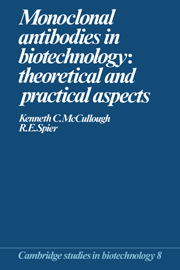Book contents
- Frontmatter
- Contents
- Acknowledgements
- 1 Introduction: the immune response
- 2 Making hybridomas (hybridoma technology)
- 3 Factors affecting successful hybridoma production
- 4 Selection of monoclonal antibody-secreting hybridoma cell lines
- 5 The large-scale production of monoclonal antibodies in vitro
- 6 In conclusion: the diversity in application of monoclonal antibodies and hybridoma technology
- References
- Index
1 - Introduction: the immune response
Published online by Cambridge University Press: 23 November 2009
- Frontmatter
- Contents
- Acknowledgements
- 1 Introduction: the immune response
- 2 Making hybridomas (hybridoma technology)
- 3 Factors affecting successful hybridoma production
- 4 Selection of monoclonal antibody-secreting hybridoma cell lines
- 5 The large-scale production of monoclonal antibodies in vitro
- 6 In conclusion: the diversity in application of monoclonal antibodies and hybridoma technology
- References
- Index
Summary
Introduction
In order to develop a clear appreciation of the problems and processes associated with the preparation and use of monoclonal antibodies (MAb), it is essential that the structure and function of the immune system be understood. The initial evidence that the body possessed a defensive system against microbial attack first came to light in the nineteenth and early twentieth centuries. This knowledge has expanded during the past 20–30 years, to give a detailed biochemical and immunochemical insight into the structure and function of the antibody molecule, the bifurcation of the immune response against foreign material (antigen) into non-specific and specific mechanisms (which has been further subdivided into cellular and humoral responses), and the genetic control of antibody diversity.
An understanding of the structure and function of the immune system is necessary for a clear appreciation of the problems and processes associated with the preparation and use of monoclonal antibodies. The stimulation of antibody production in vivo(the humoral response) and the other components of the immune response will then be introduced, and the structure of the antibody molecule and its differentiation into classes and subclasses described and related, where appropriate, to immunological functions. This will assist with the understanding of the properties and functions of monoclonal antibodies, and of both how and why they can be produced. Although the immune system is a complex network of reactions and interactions, the antibody response will be described in the greatest detail, since it is the antibody response which is of direct relevance to the production of monoclonal antibodies.
- Type
- Chapter
- Information
- Monoclonal Antibodies in BiotechnologyTheoretical and Practical Aspects, pp. 1 - 89Publisher: Cambridge University PressPrint publication year: 1990



